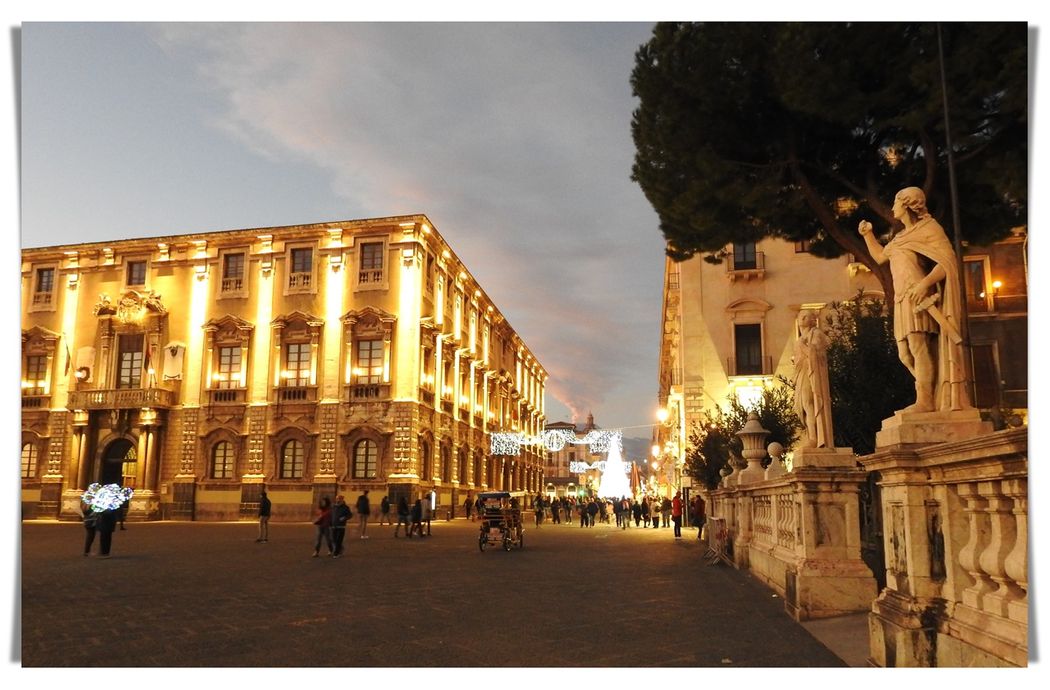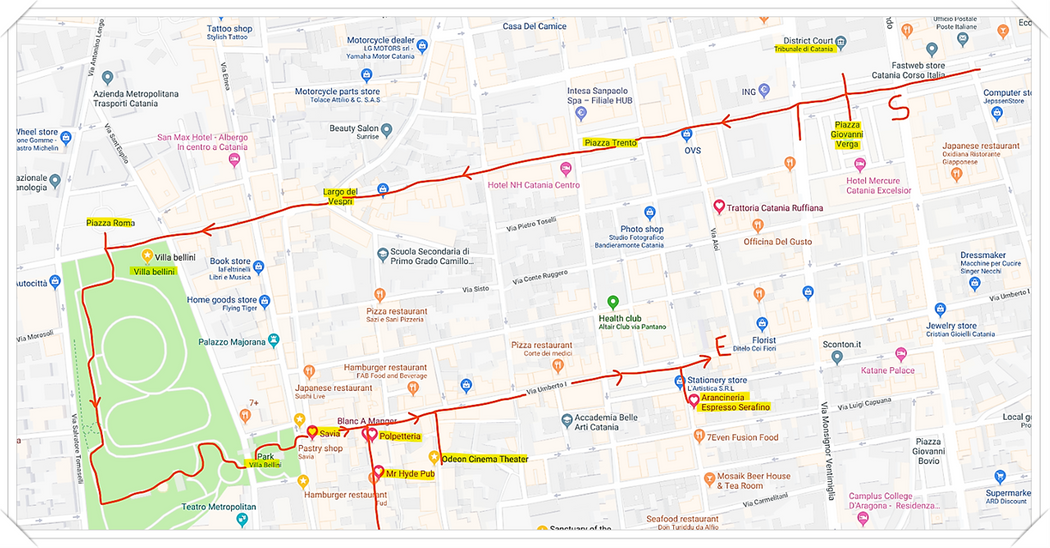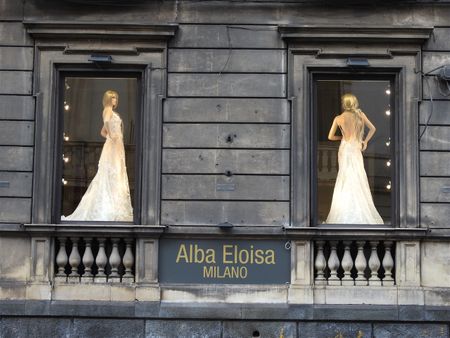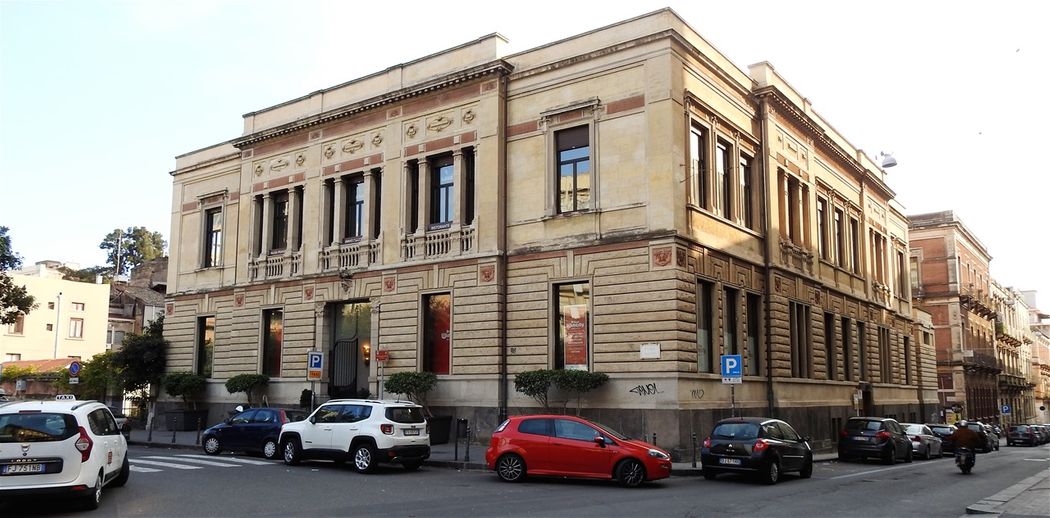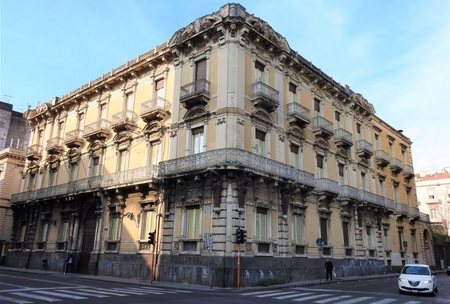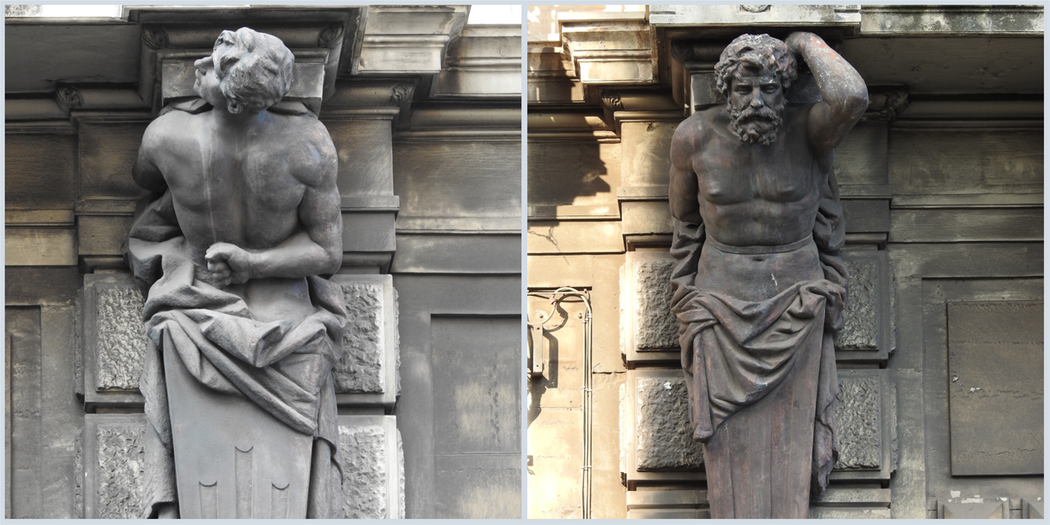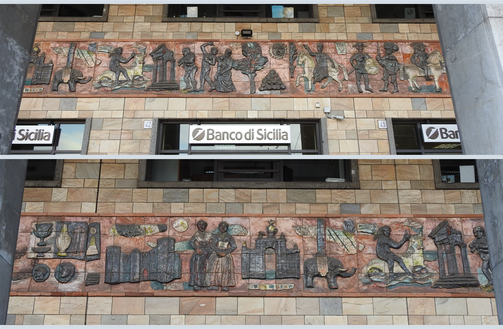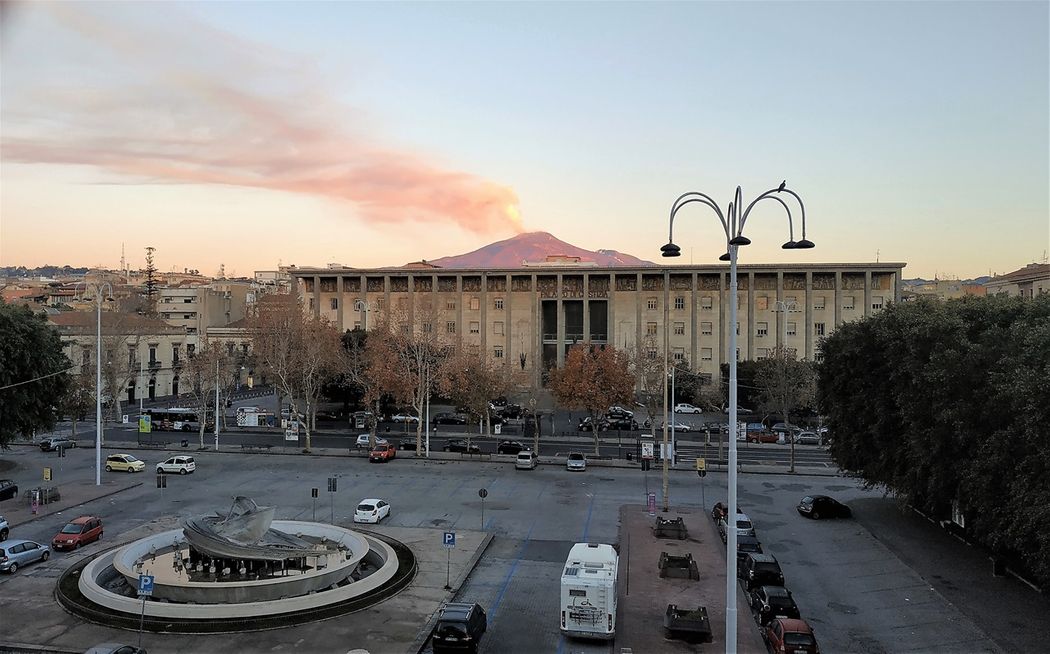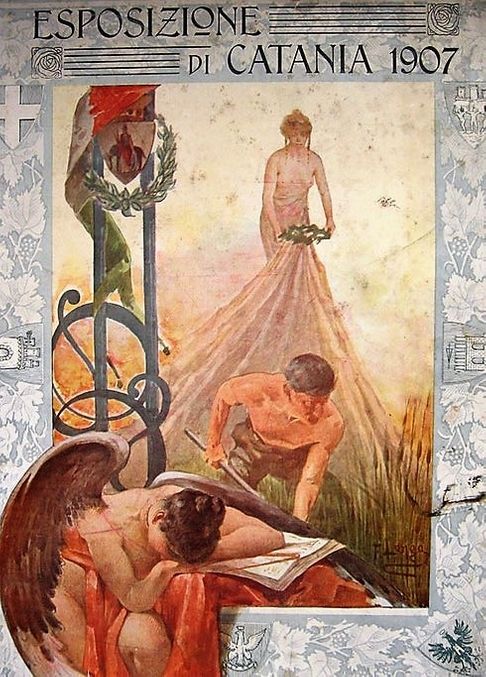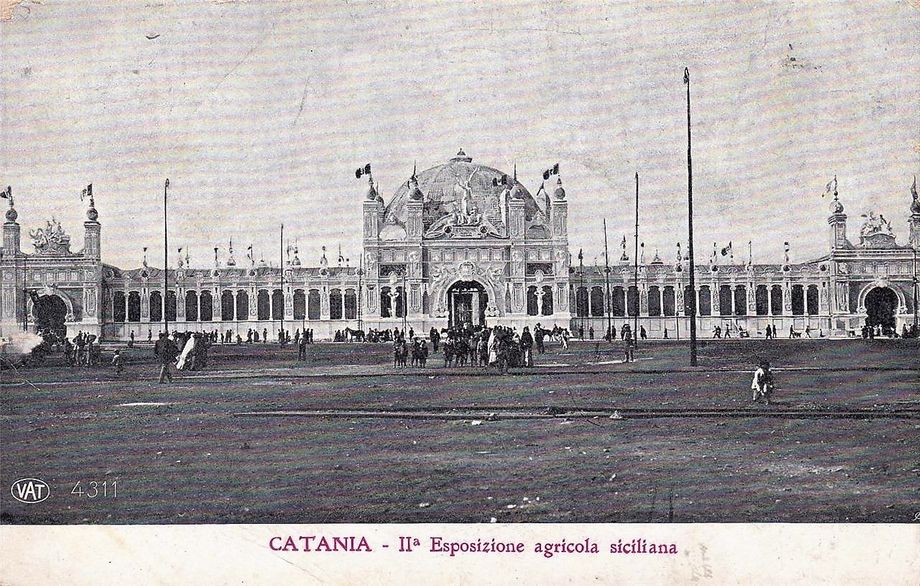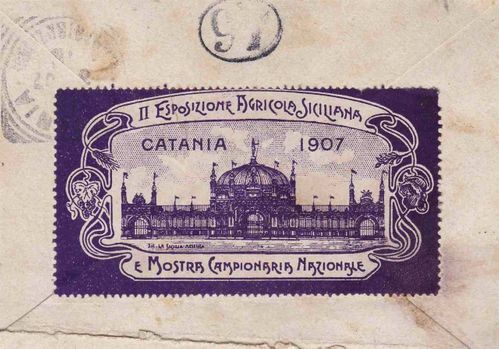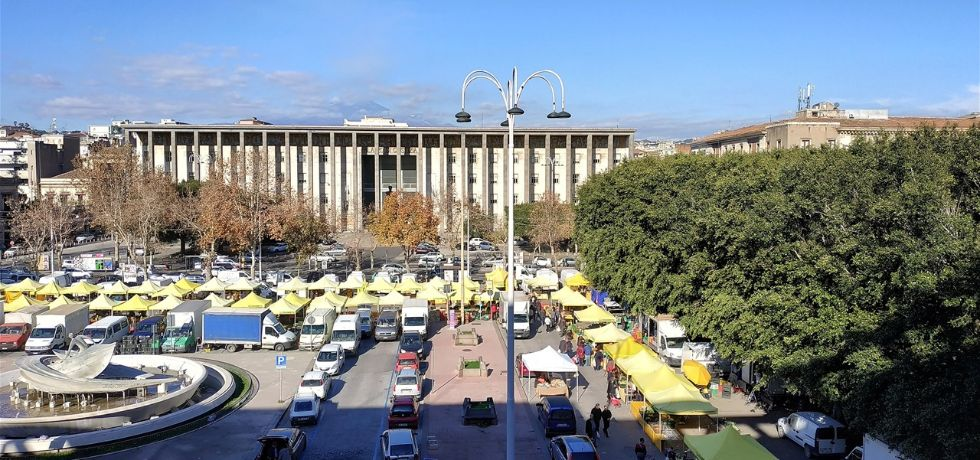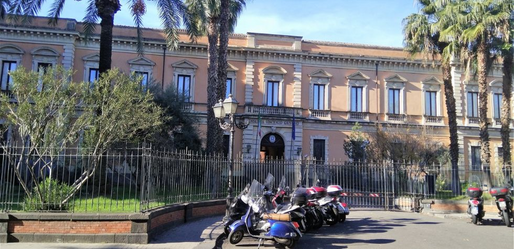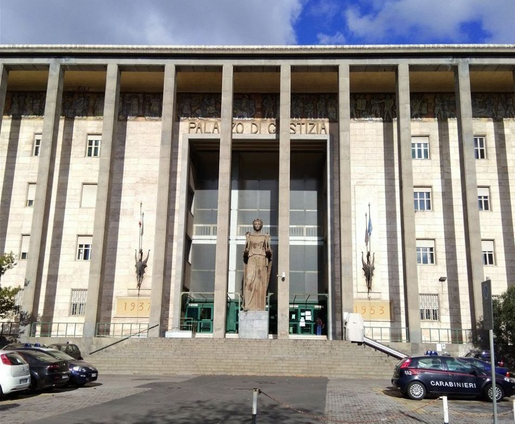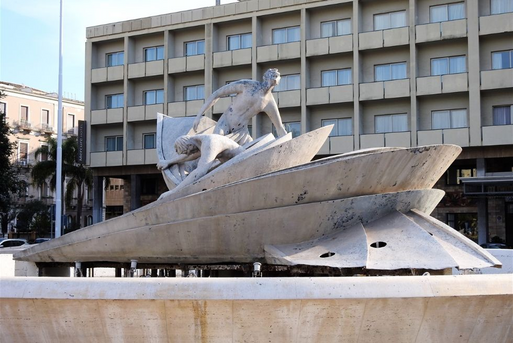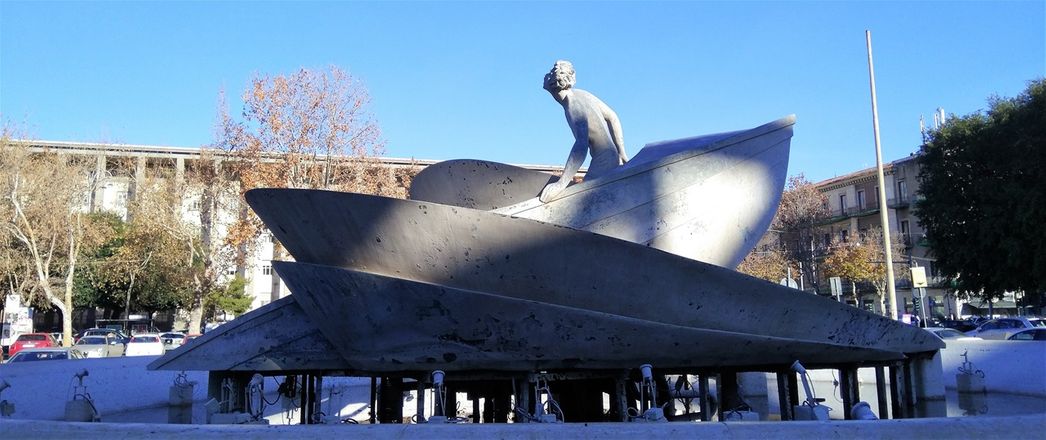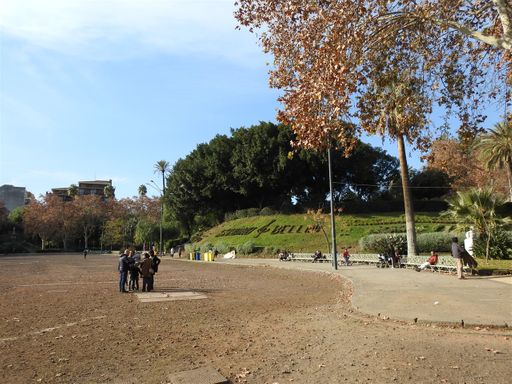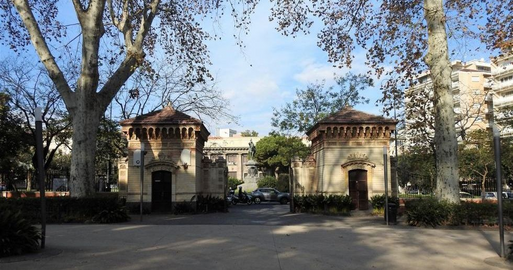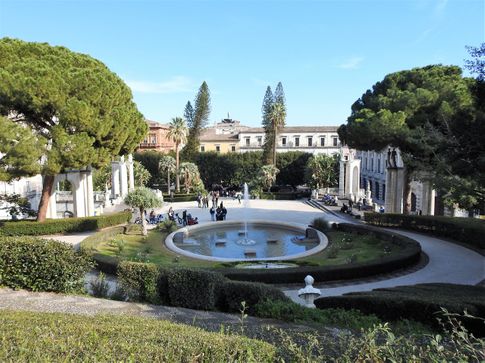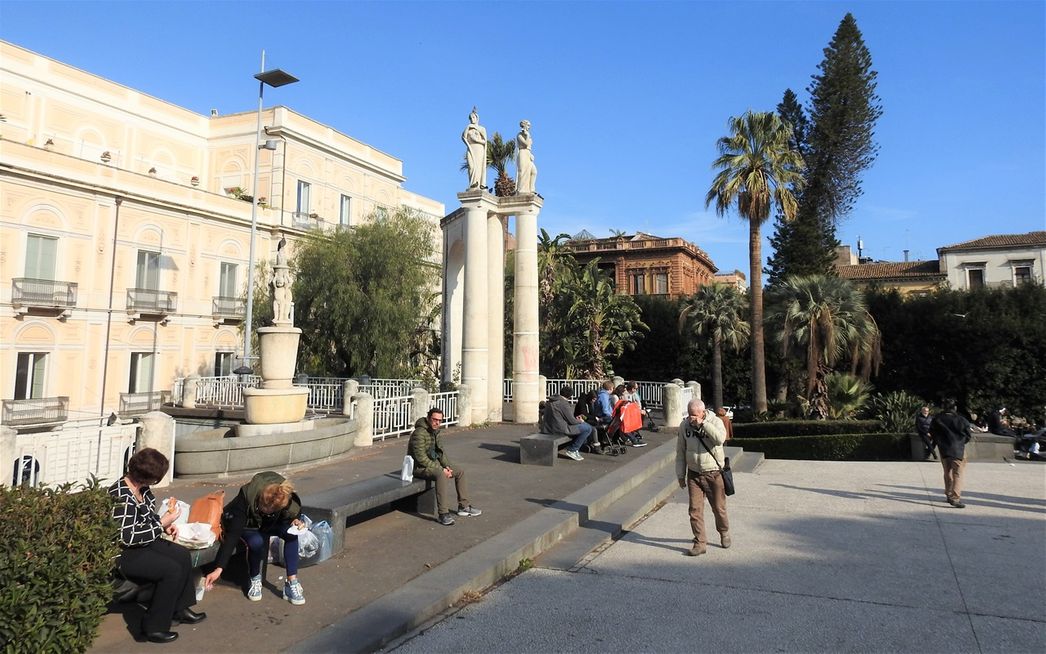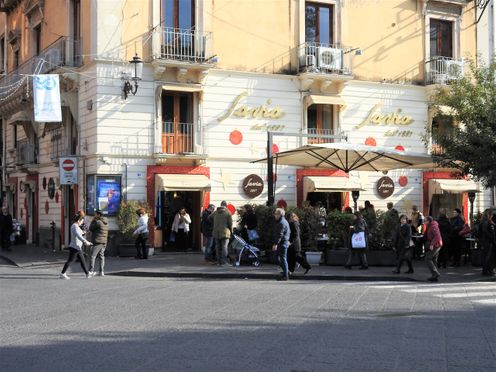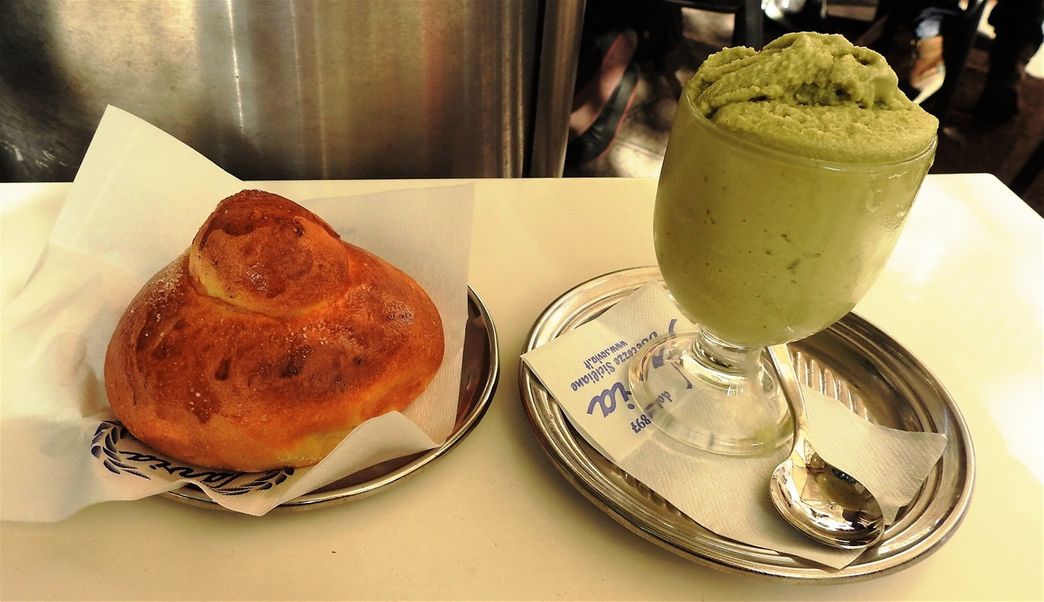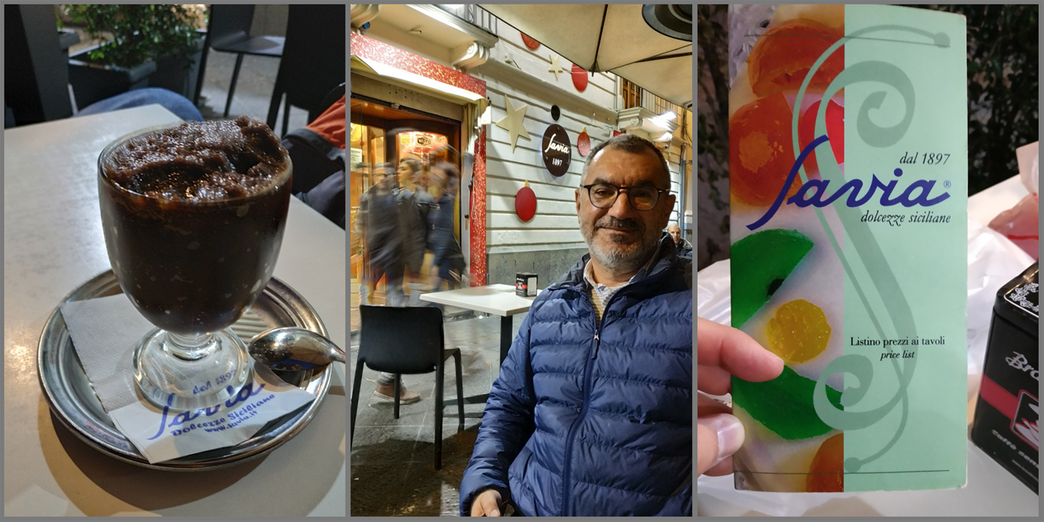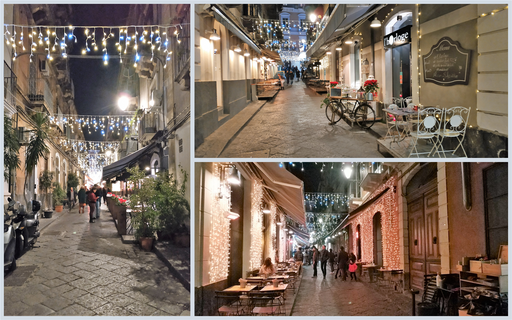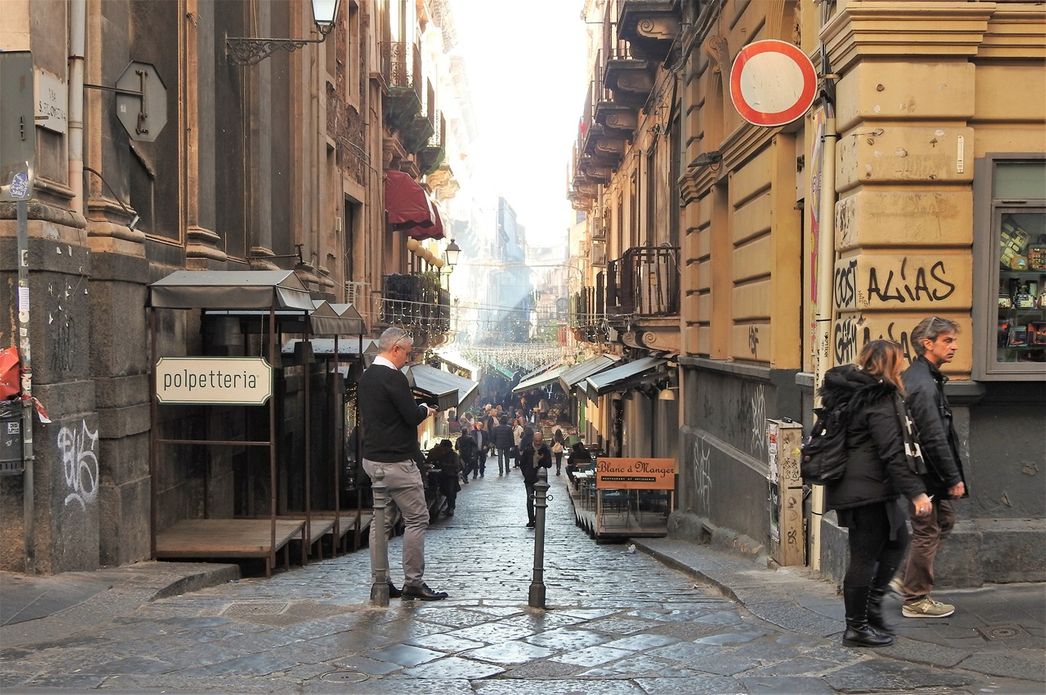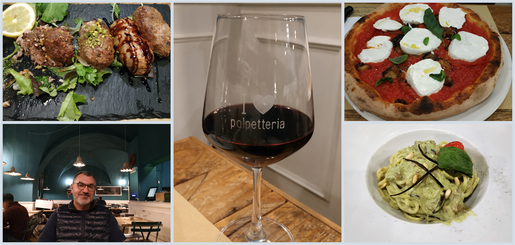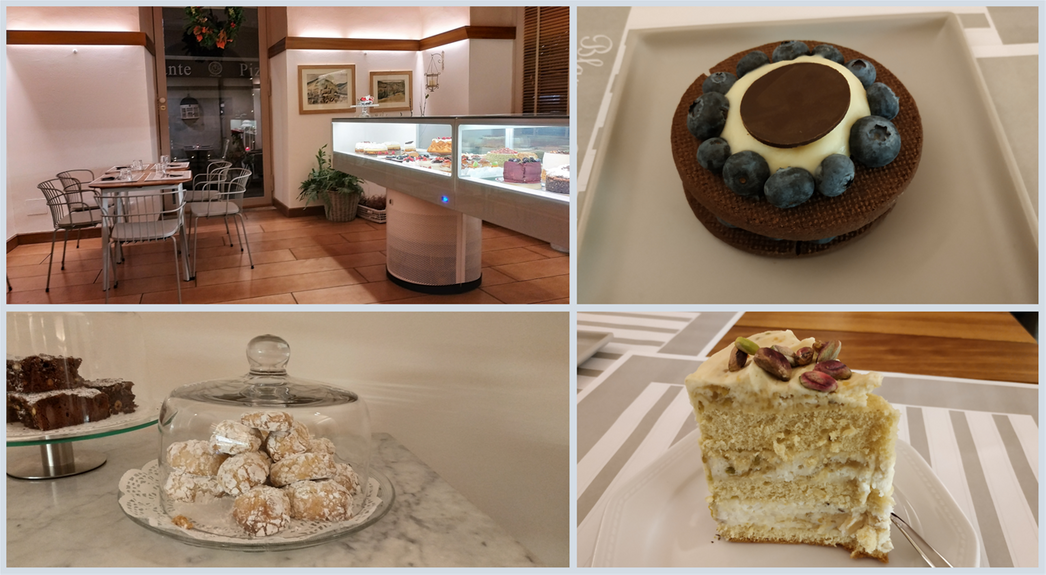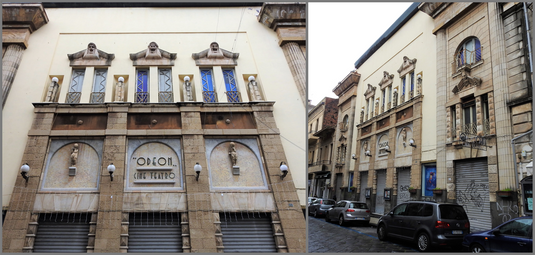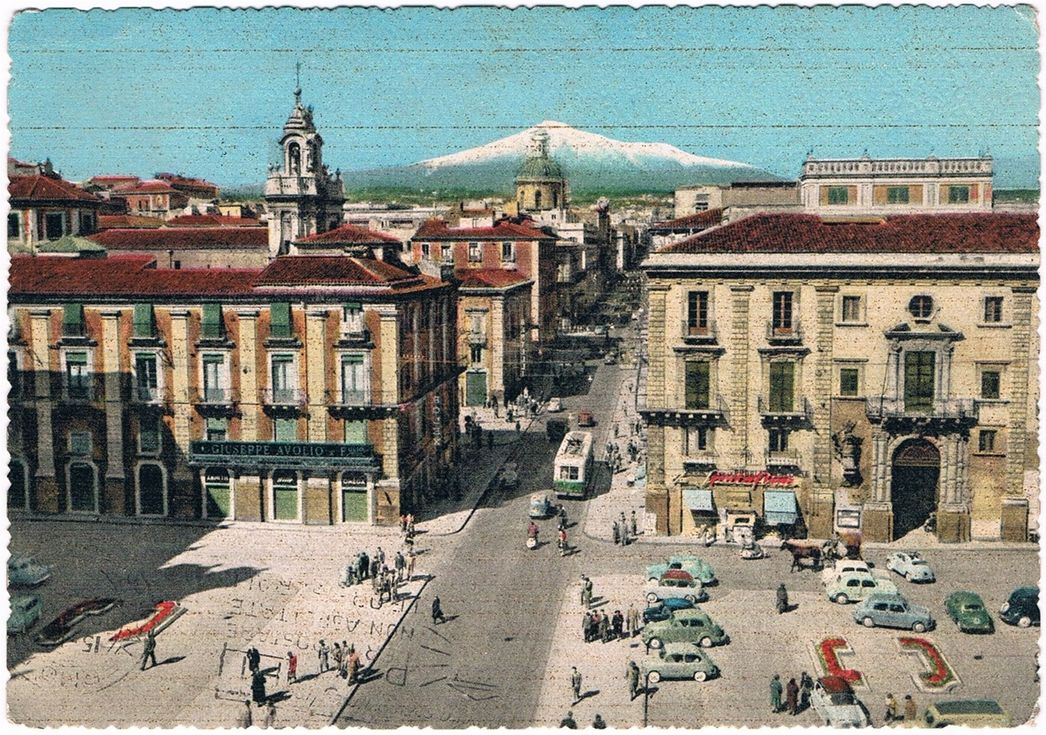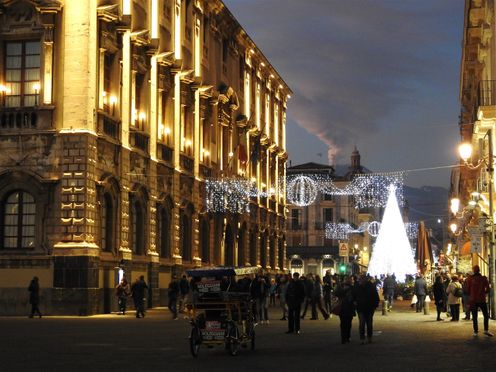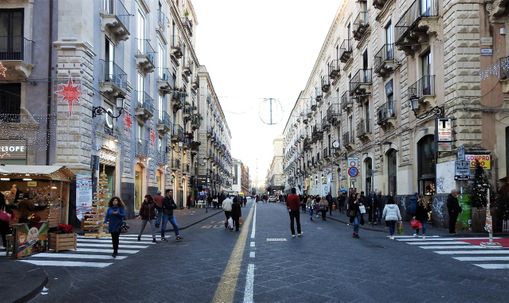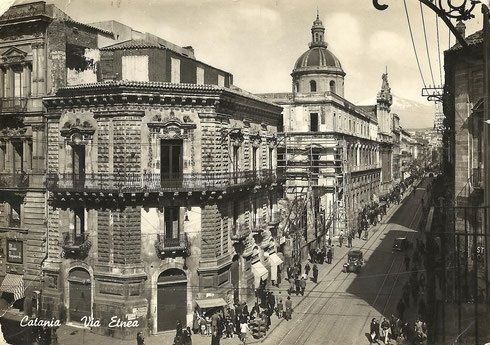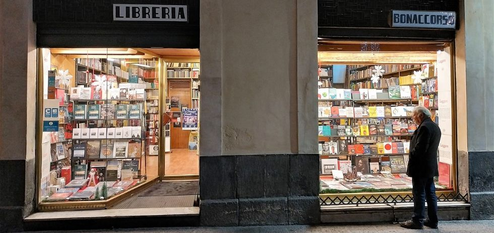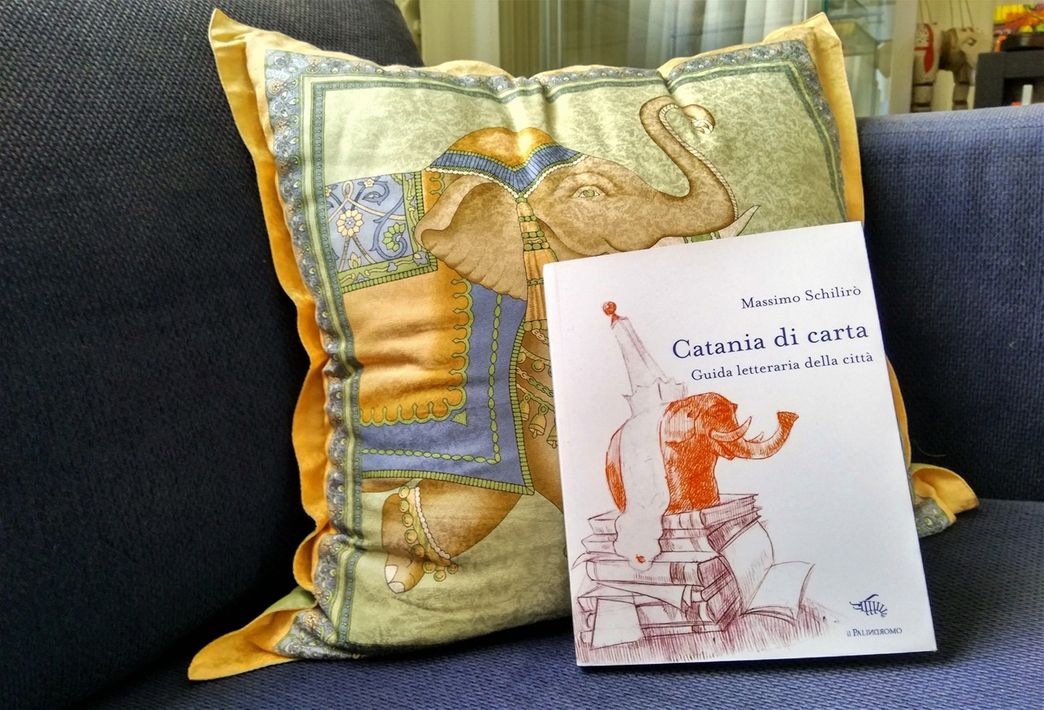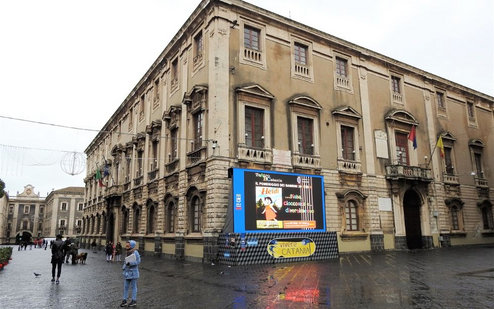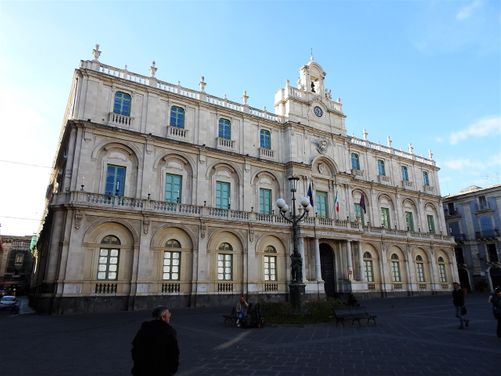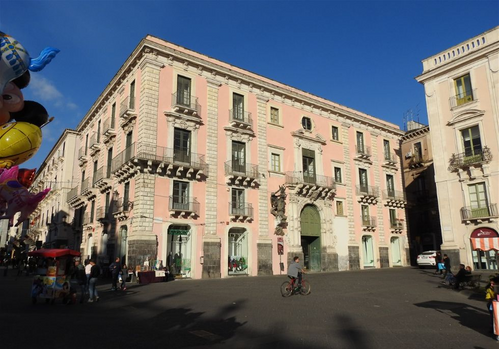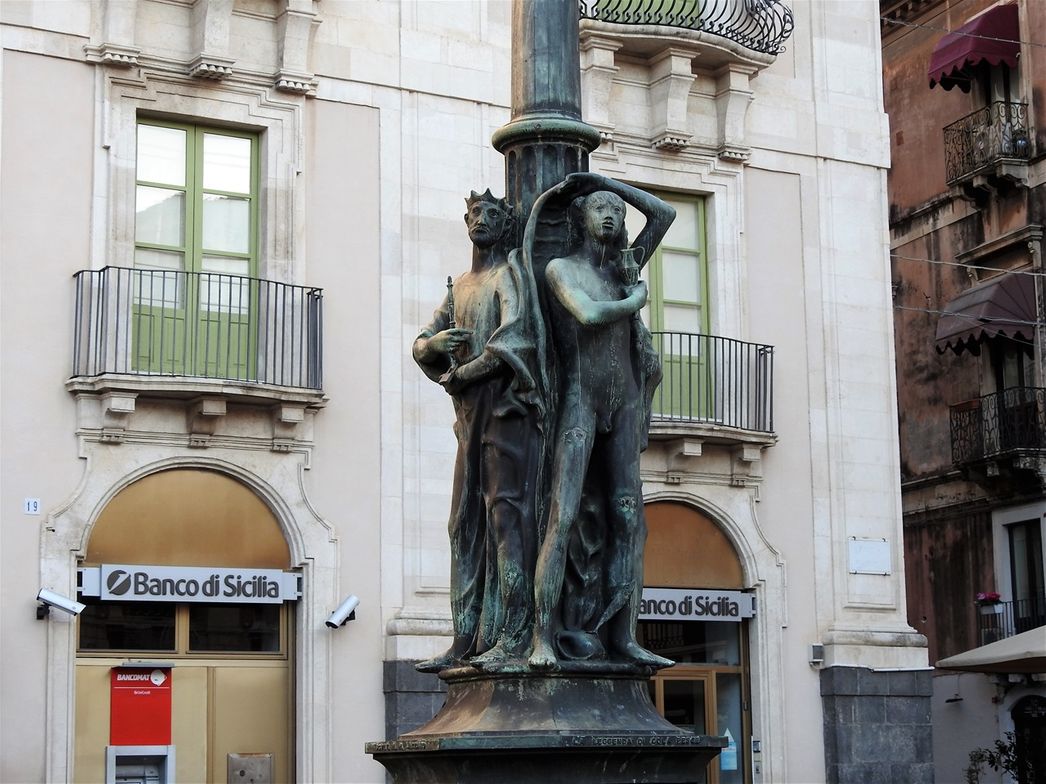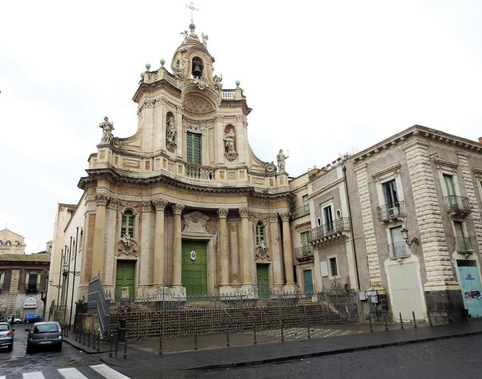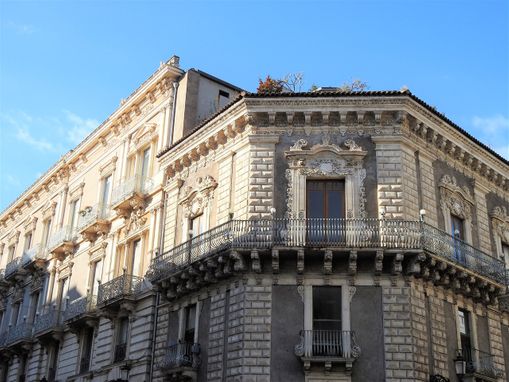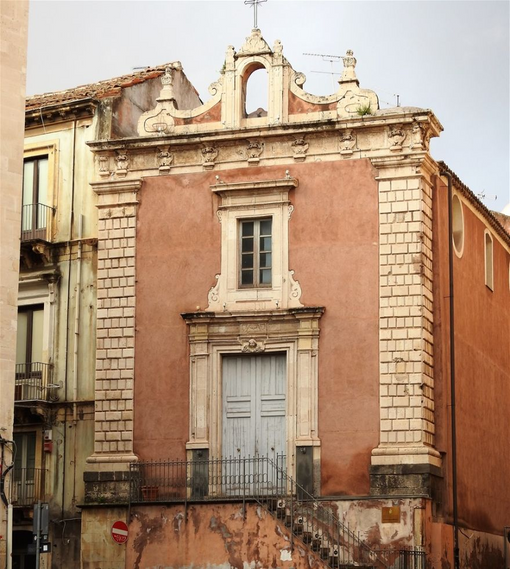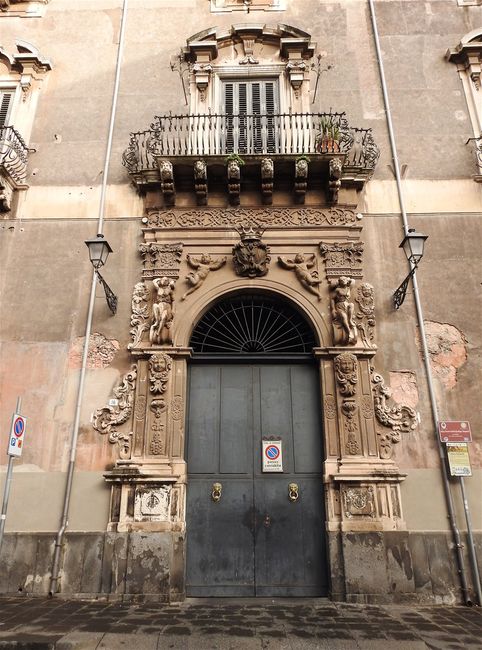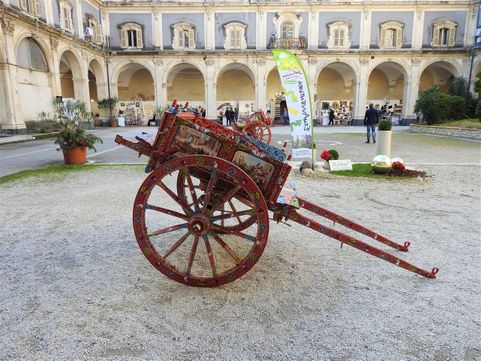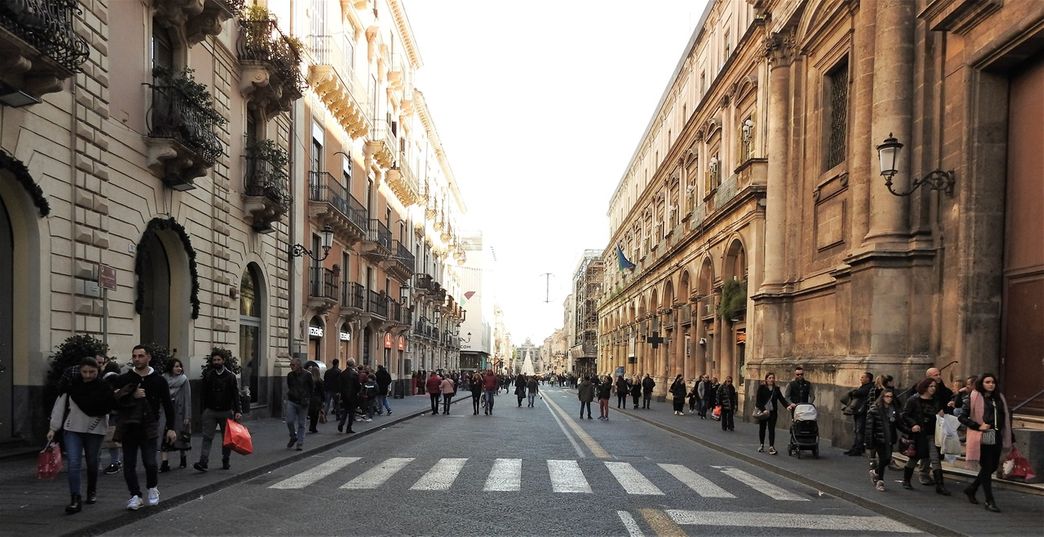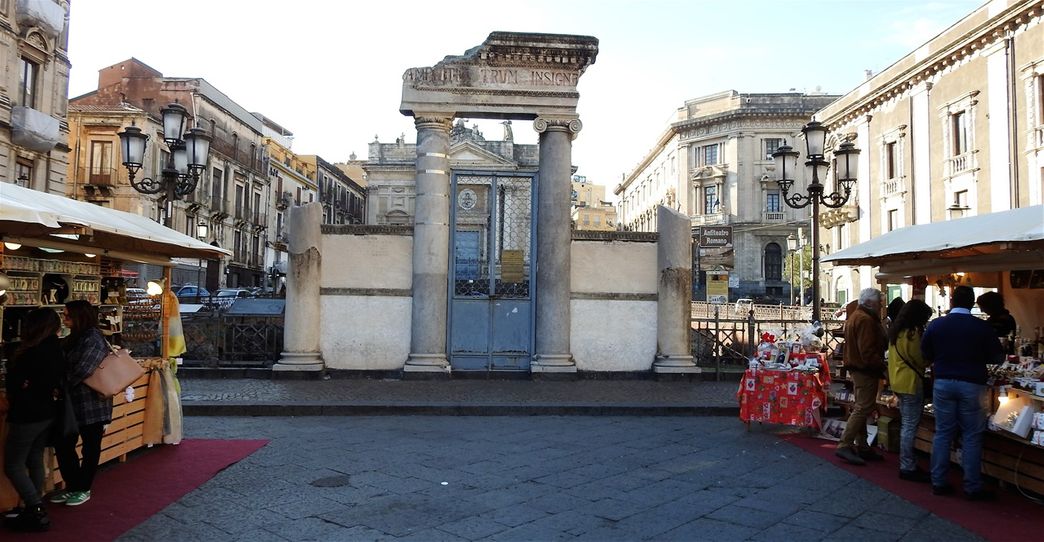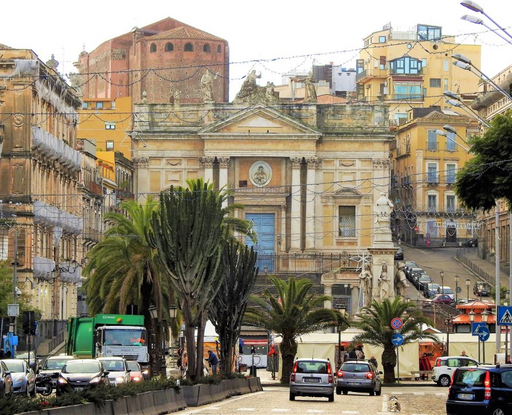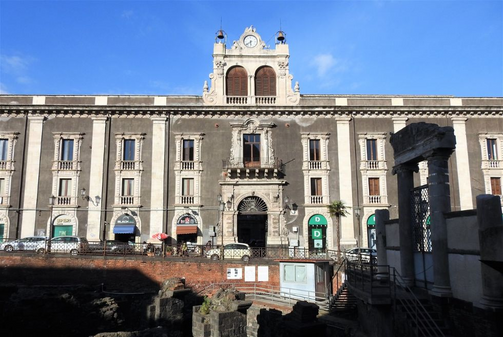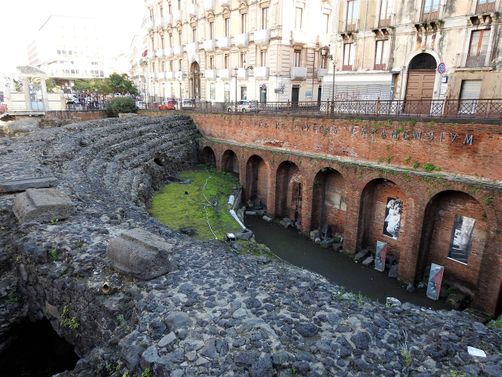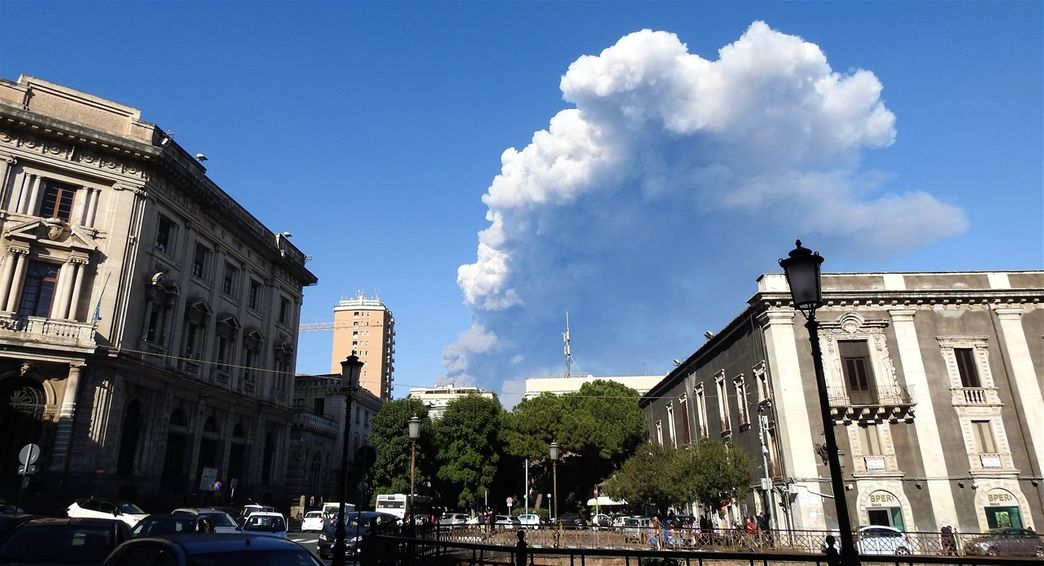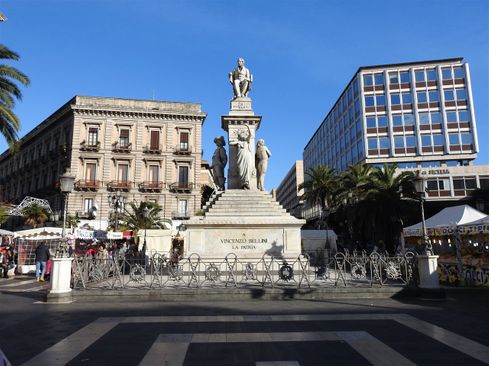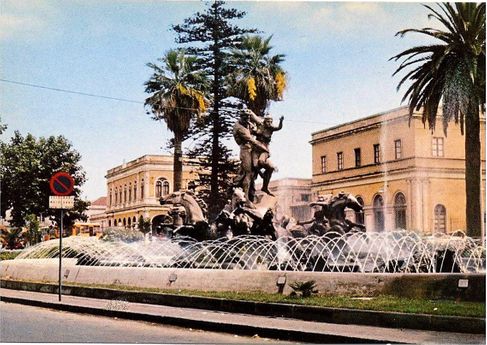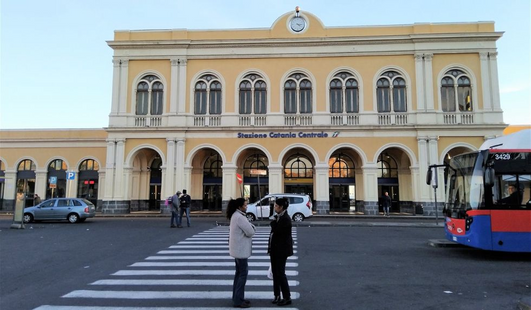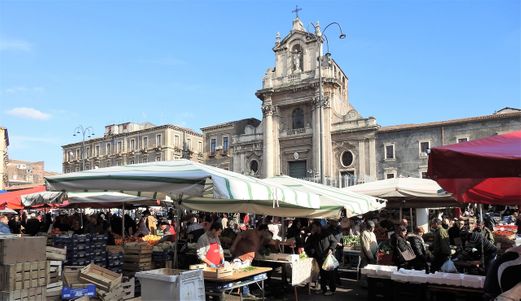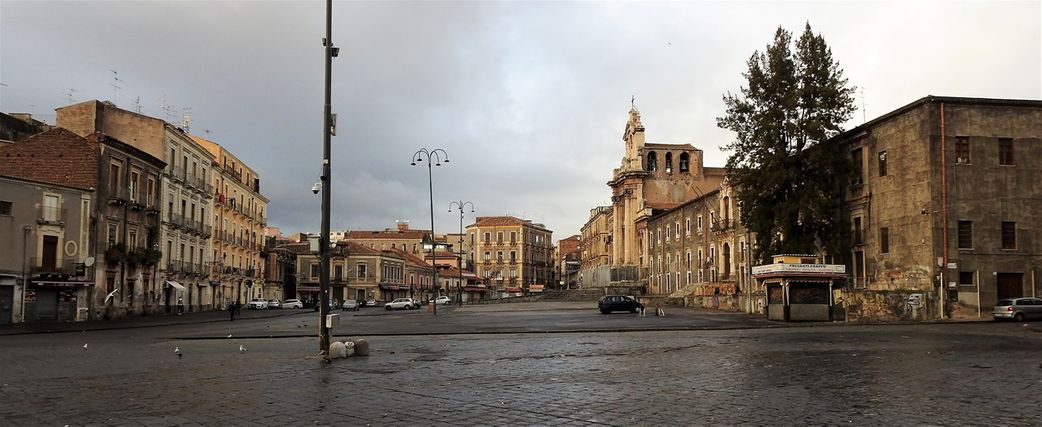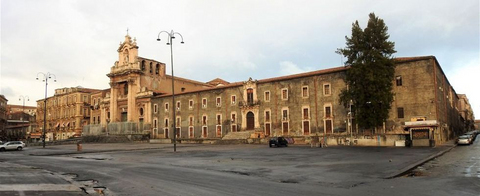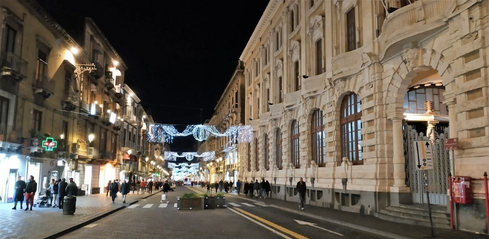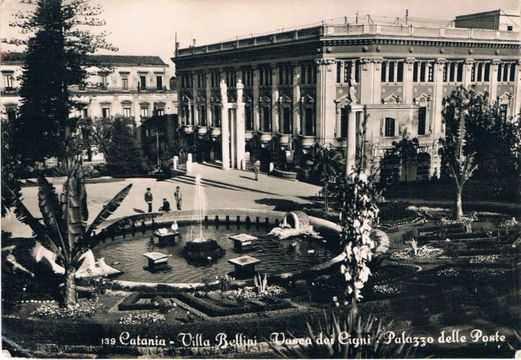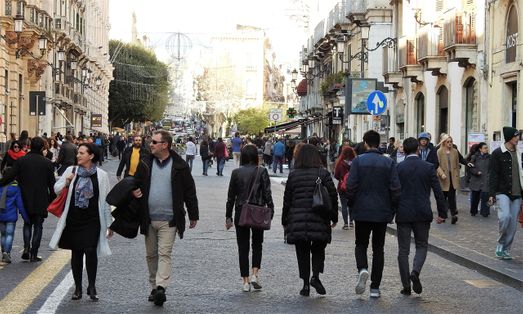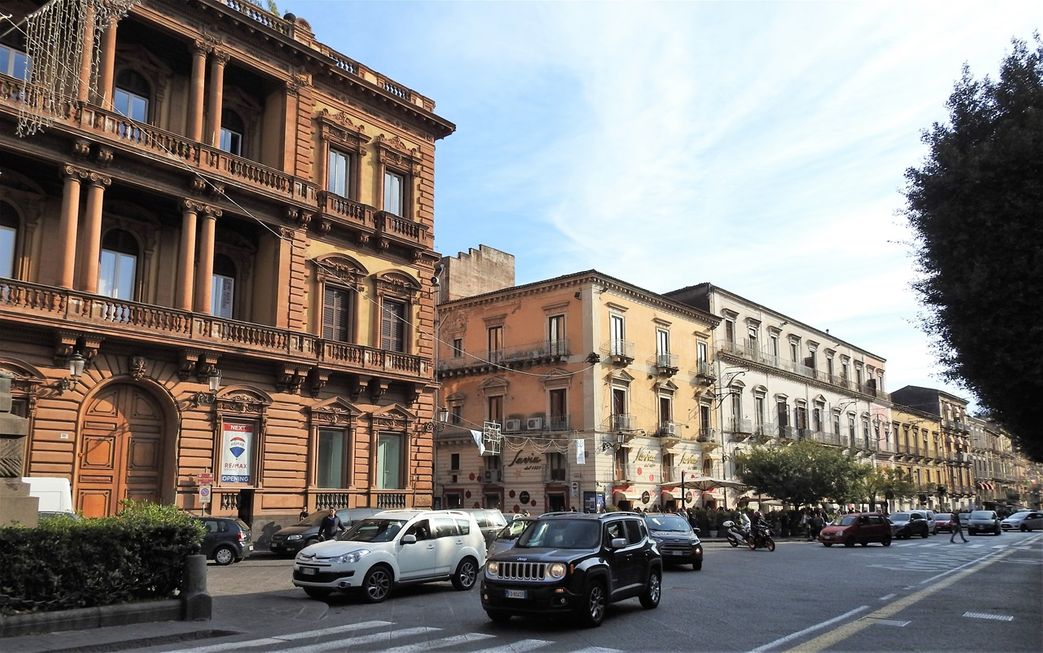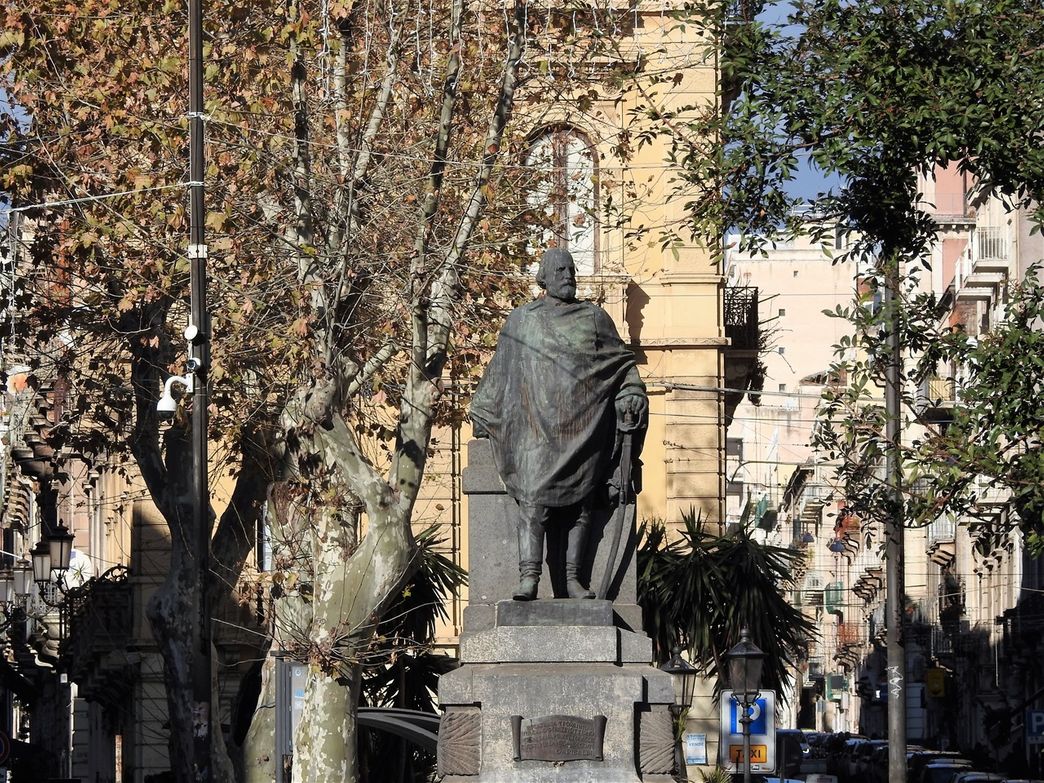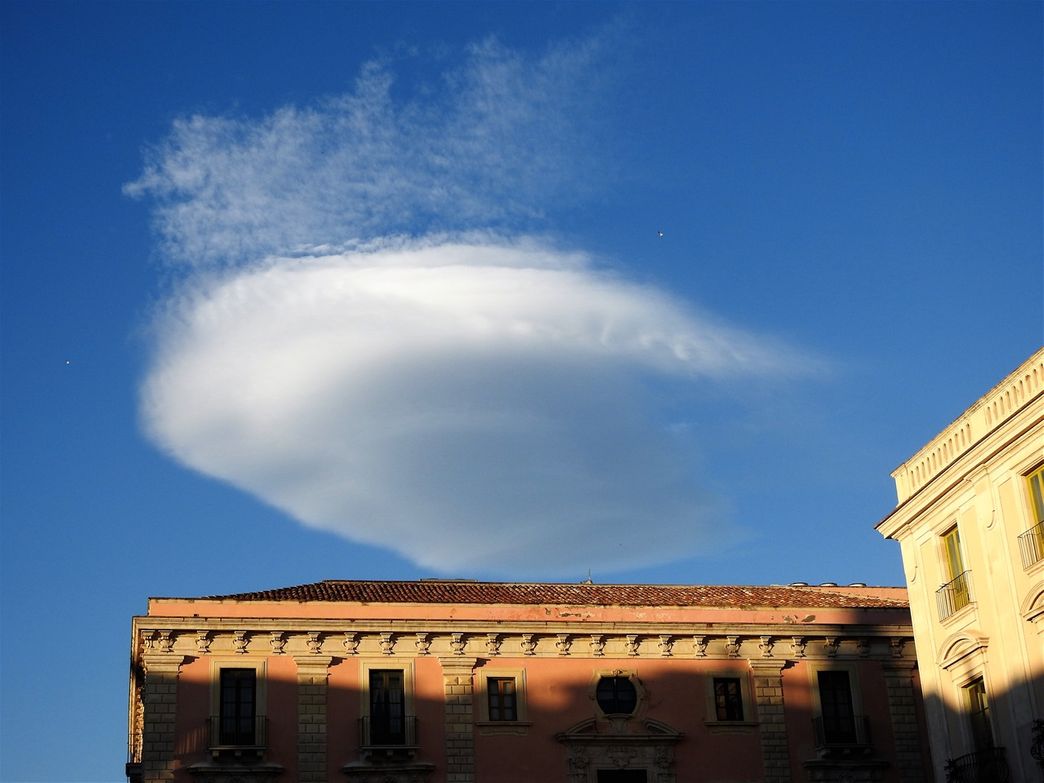CATANIA
PART 2:
two walks around the city
December 2018
walk no 1
NORTH OF THE CENTER
For the purpose of this article, I consider “North of the center” the strip included between the two major streets: Viale XX Settembre which continues east as Corso Italia, and Via Umberto I.
The walk North of the Center (S=start, E=end).
The Corso Italia street, running from the seaside (Piazza Europa) to Via Etna (halfway, at Piazza Giovanni Verga, it changes its name to Viale XX Settembre), is one of the most elegant streets in the city. It is the place to go for upscale brand name shopping - the street is lined with world-famous brand name stores and boutiques (such as Prada, Gucci, Armani), and breathes a sophisticated air. Piazza Europa hosts some of the best cafés in the city (Caffè Europa and the Caffè Epoca).
Shop window on Corso Italia.
The Art Noveau "Palazzina della Società Elettrica" in Piazza Trento. Built in 1911 by the catanese architect Francesco Fichera.
Palazzo Monaco on Corso Italia (Viale XX Settembre).
The street is home of some beautiful late early 20th century villas:
Palazzo Monaco, Villa Manganelli (Corso Italia 37, 1907), Villa Cigno-Cocuzza o Villa del Grado (Corso Italia 209, 1903-1908), Villa Bonajuto (Corso Italia 266, 1929), Villa Miranda (Viale XX Settembre 64, 1906-1908), and many more.
Decorative details on Palazzo Monaco facade.
Certainly, though, the most important spot for the tourist to visit is Piazza Giovanni Verga. Piazza has a square shape and is crossed by Corso Italia, which divides it into two equal parts. The north side is bordered by the facade of the Palace of Justice (Palazzo di Giustizia), the south side by the main facade of the Excelsior hotel (I stayed here during my visit in Catania) and the east and west sides by two long streets which cross the whole city center from south to north. At the center of the southern section of the square stands the monumental Malavoglia fountain.
Hotel Mercure Catania Excelsior facade decorations.
Piazza Verga photographed at dusk from my room at Hotel Mercure Catania Excelsior. At the background, Etna smoking.
The dedication to memory of the writer and photographer Giovanni Verga took place only in the twentieth century. Previously the square, completely peripheral to the city, was a real military training camp and carried the generic name of "piazza d'Armi". The square had a larger extension than the current one and was rectangular in shape. In the early twentieth century it was chosen to set up the important "Sicilian agricultural exhibition of 1907" and after that the square was renamed "Piazza Esposizione" name remained in popular memory until recent times. The task of setting up the structures that would host the exhibition was entrusted to the engineer Luciano Franco who created the works, in the spirit of the early twentieth century in Catania, according to the Art Nouveau style (also known in Sicily as “stile Liberty”).
The building of the Exposition (Palazzo dell’Esposizione) was a building in eclectic architecture of Gothic-oriental style, built for the occasion by the famous Tommaso Malerba.
A poster for the "Sicilian agricultural exhibition of 1907".
The Palazzo dell’Esposizione.
The "Royal Pavilion" was created by Salvatore De Gregorio, while Alessandro Abate was responsible for decorating the Vestibule, where the dome of the Great Ottagono stands out. The decorations of Abate depict scenes of work of the Etna peasants, captured by the divine grace of the goddess Ceres. From here you had access to the garden, embellished by several kiosks, located in the center, from which it was possible to enter the four pavilions, introduced by arches. The buildings had the fate of almost all the big Expositions of that era in Europe and destroyed some years later.
Palazzo dell’Esposizione depicted on a stamp from 1907.
Piazza Verga during a Sunday market. Palazzo di Giustizia in the center.
In 1936, on the north side of the square, work began on the construction of the majestic Palace of Justice-Palazzo di Giustizia (completed in 1953) which is accessed by means of an imposing staircase in lava basalt dominated by a bronze statue of the Lady Justice (the goddess of justice in the Roman mythology), with scale and sword in the hands, placed at the entrance. The statue, seven and a half meters high, was sculpted by Mimì Maria Lazzaro in 1953 and moved and positioned between the pillars of the entrance in 1955 by the civil engineering department.
The Carabinieri barracks on Piazza Verga.
In 1975 in the middle of the southern part of the square, in front of the current building of the Excelsior hotel, the Fontana dei Malavoglia (Malavoglia fountain) was placed; this incorporates a sculptural complex of great emotional impact, one of the last works of the Catanese sculptor Carmelo Mendola (1895-1976, known also for Palazzo delle Poste in Catania and Palazzo delle Poste in Siracusa), which represents the shipwreck of the "Provvidenza" key scene of Verga’s story “I Malavoglia” (see also my trip to Aci Trezza)
Lady Justice in front of Palace of Justice.
On the south-west side of the square, a Carabinieri barracks were built in place of the old barracks.
The square gradually gained more and more importance following the expansion of the city to the north. Today, every Sunday, takes place a big fresh-products market, while the rest of the week, the square is transformed into a giant car parking lot.
Fontana dei Malavoglia. At the background the "Hotel Mercure Catania Excelsior".
The artist was able to grasp the tension between the pained bodies but at the same time in full action in a manner faithful to what was described by Verga in the corresponding passage of the novel:
«Si udiva il vento sibilare nella vela della Provvidenza e la fune che suonava come una corda di chitarra. All'improvviso il vento si mise a fischiare al pari della macchina della ferrovia, quando esce dal buco del monte, sopra Trezza, e arrivò un'ondata che non si era vista da dove fosse venuta, la quale fece scricchiolare la Provvidenza come un sacco di noci, e la buttò in aria. […] In questo momento s'udì uno schianto: la Provvidenza, che prima si era curvata su di un fianco, si rilevò come una molla, e per poco non sbalzò tutti in mare; l'antenna insieme alla vela cadde sulla barca rotta come un filo di paglia. Allora si udì una voce che gridava: - Ahi! come di uno che stesse per morire. […] Ad un tratto un colpo di vento la strappò netta e se la portò via sibilando. Allora i due fratelli poterono sbrogliare del tutto il troncone dell'antenna e buttarlo in mare. La barca si raddrizzò, ma padron 'Ntoni non si raddrizzò, lui, e non rispondeva più a 'Ntoni che lo chiamava. Ora, quando il mare e il vento gridano insieme, non c'è cosa che faccia più paura del non udirsi rispondere alla voce che chiama.»
Fontana dei Malavoglia.
At its western end Viale XX Settembre, passes in front of the best and most appraised park of the city: Villa Bellini. Also known as Giardino Bellini, this green “oasis” is the oldest urban park of Catania. For the people of Catania, Giardino Bellini is simply “ 'a Villa”, a place for recreation, relaxation, walks and meetings.
Here at piazza Roma, is located the northern entrance of the park. This beautiful square is dominated by the monumental façade with eight Doric columns of the building, that today houses the commercial institute De Felice Giuffrida-Olivetti. In the center of the square stands the sculpture of “Vittorio Emanuele I di Savoia”, by Mario Rutelli, which was inaugurated in September 1911.
Enter the park here and cross it from north to south.
Campo Sgambamento, Villa Bellini.
The northern entrance of Villa Bellini and the sculpture of “Vittorio Emanuele I di Savoia” in Via Roma in the background.
Villa occupies, as a whole, an area of 71 thousand m2 within which they are arranged, flower beds, squares for sporting and musical events, benches for rest and reading, shaded paths and fountains. Part of the space, now occupied by the villa, was the old 'Labirinto', a picturesque garden that surrounded a building built in the 18th century by Ignazio Paternò Castello, Prince of Biscari. The habit of building gardens with intricate paths in which guests could easily be lost, was one of the many fashions widespread in 18th century Europe, when the rationality and imagination, the taste for 'wonders' and rigor were merged and coexisted.
Villa Bellini. The kiosque on the right.
Around the mid-nineteenth century the City of Catania bought the villa of the Paternò Castello family to build a public park. In the following years new land was acquired to give even more space to the garden and allow the population of Catania to go to a large green area, rich in floral decorations, palm trees, centenarian trees and fountains. Among the pages of a brief but essential guide of Catania, published in 1899, we find a tasty description of the garden that, since its opening, was considered one of the most beautiful in Europe.
The main entrance of Villa Bellini, on Via Etnea.
The part of Villa Bellini just inside the main entrance on Via Etnea.
In 1933 the artist M.M. Lazarus placed the statues that personify the arts in the square of the main entrance.
Some of the statues in Villa Bellini.
In recent years, Villa Bellini has hosted prestigious performances that enliven the evenings of the Catania and Italian and foreign visitors.
Exit Villa Bellini from its main entrance located at the confluence of Via Etnea and Via Umberto I.
Via Umberto I is not as impressive as Corso Italia, but it is one of the main commercial streets full of shops, cafés and restaurants (mainly at its western half).
It is here, though, at this point opposite the Villa main entrance, that we meet the most important “tourist attraction” of Via Umberto I: Savia, the most historic and famous Pasticceria (since 1897). This pasticceria offers all the typical sicilian dolci like: Cassata Siciliana, Frutta martorana, Olivette, Cannoli alla ricotta, Torta alle mandorle, Torta Savoia, etc. Savia is a must, even though staff is not very polite (if not rude). There is a small sitting room inside and a bigger one outside on Via Etnea. This is the place to sit with a glass of granita and a warm brioche and watch people pass by.
Pasticceria Savia.
Pasticceria Savia. The traditional Sicilian treat: brioche and granita.
Pasticceria Savia.
Via Santa Filomena.
The square defined by Via Umberto I, Via Romeo, Via Pacini and Via Etnea is a very vivid area for food and nightlife. The center of the area is Via Santa Filomena (the first parallel to Via Etnea on the east) which is beautifully decorated and lit. Beautiful restaurants and bars, one next to the other, are ready to cater everyone’s culinary needs.
There is even a small bookstore on Via Santa Filomena, "Libreria Vicolo Stretto", which stays open till late to escort your night out!
Via Santa Filomena seen from Via Umberto I.
I recommend to have your dinner at the “Polpetteria” for tasty and juice meatballs or other more typical Sicilian dishes. Then have your dessert at “Blanc A Manger”, located just opposite from Polpetteria, and finish your evening at “Mr Hyde Irish Pub”. Of course, the choices are many more that just these places: just choose the shop that looks nice to you and step in. I am sure you will not be disappointed at all.
At the “Polpetteria”.
At “Blanc A Manger”.
On the parallel street to the east of Via Santa Filomena, on Via Filippo Corridoni stands the beautifully restored art deco theater, the “Odeon Cinema Theater”, which was designed by Carmelo Aloisi. The opening of the theater took place on the 11 March 1932 with the 1931 Alfred Santell film “Daddy Long Legs” with Janet Gaynor and Warner Baxter.
Odeon Cinema Theater, on Via Filippo Corridoni.
walk no 2
VIA ETNEA
A 1959 card postal depicting Via Etnea. Piazza Università is in the foreground and Mount Etna at the background.
Via Etnea is one of the two main streets of the historic center of Catania (the other is Via Vittorio Emanuele II - see Walk No 4) and certainly the most visited and walked. It runs in the south-north direction, has a straight line and is about 2.8 kilometers long. It goes from Piazza del Duomo to the Tondo Gioeni. Even though the street is very long only the lower half (south of Villa Bellini park) of it is of any interest to the tourists.
Via Etnea emerged only at the end of the seventeenth century following the disastrous earthquake of 11 January 1693. The earthquake levelled almost the whole city of Catania and under the wreckage perished about two-thirds of its inhabitants. The Duke of Camastra, sent by the viceroy with the mandate to oversee the reconstruction of the city, decided to trace the new roads according to orthogonal directions starting from the cathedral that was one of the few buildings not completely destroyed.
Via Etnea with Mount Etna smoking at the background.
Via Etnea.
Thus, a road was created that runs from the cathedral towards Mount Etna and a road that crossed it with east-west route (what is today Via Vittorio Emanuele II). Via Etnea was born. The street was called Via Duca di Uzeda, in honor of the viceroy of the time. Over the centuries its name changed to Via Stesicorea and finally to the current Via Etnea as the road heads towards Mount Etna. The road was then only about seven hundred meters long and ended in the current Piazza Stesicoro, then called Porta di Aci, as here located one of the gates of the city of Catania.
The perpendicular road, now Via Vittorio Emanuele II, was called Via Lanza and later Corso and finally in the 19th century it took its present name.
The buildings that were built along the two roads were built in the Sicilian baroque style by the architects Giovanni Battista Vaccarini and Francesco Battaglia. Along the Via Etnea were built seven churches starting from the cathedral located in Piazza Duomo and many palaces of the Catanese nobility and public buildings were built: starting from Piazza Duomo, you will find the Palazzo degli Elefanti, what is today the City Hall. Piazza del Duomo and its buildings are described in 'walk no3'.
Via Etnea - 4 Canti.
Via Etnea has recently been repaved with Etna lava stones, and is now a pedestrian street in the stretch that goes from Piazza del Duomo to the Quattro Canti. In the section that goes from the Quattro Canti to the Bellini Villa park, it is instead used only by means of public transport (buses and taxis).
Via Etnea is the main shopping street and one of the busiest streets in the city both during the day and at night. In fact, in the surrounding streets there are lots of local restaurants, breweries, pubs, cafés and pizzerias.
Libreria Bonaccorso at the beginning of Via Etnea (Piazza Duomo).
WALK STARTS at Piazza del Duomo, which also marks the beginning of Via Etnea.
You leave the square behind you and start walking northbound, having always the magnificent Mount Etna in view. Just a block away, you meet Piazza Università, but just before this you can pop into a beautiful little bookshop, Libreria Bonaccorso, for some local interest books.
Souvenir from Libreria Bonaccorso.
The existence of Piazza Università dates back to at least 1696 when, on the west side, the building of the University (Palazzo dell'Università) was built after the destruction caused by the seismic event of 1693. The building was built on the design of several architects including Francesco and Antonino Battaglia and Giovanni Battista Vaccarini. On the east side, in front of the University building, is Palazzo San Giuliano built in 1738, for the Paternò Castello marquises of San Giuliano, on a project by the architect Giovanni Battista Vaccarini. Today it also houses part of the University of Catania.
The back side of the Palazzo degli Elefanti.
Palazzo dell'Università on Piazza Università.
To the south of the square are the back side of the Palazzo degli Elefanti and Palazzo Sant’ Alfano dating back to the second half of the eighteenth century. On the ground floor of Palazzo Sant’ Alfano there are a couple of cafes, where you can enjoy your coffee or your granita and Sicilian pastries.
I had a brioche with pistachio ice cream and a pistachio cannolo at cafe "Prestipino".
A snack at cafe "Prestipino" (Via Etnea, 30/32): brioche with pistachio ice cream and pistachio cannolo.
The north side, which concludes the square, houses the Gioieni d'Angiò building (built in 1743 and commissioned by the Duke Gioeni d'Angiò as a family palace) and Palazzo La Piana to the northwest.
In the square there are four bronze artistic candlesticks, made in 1957 by the Catanese sculptors Mimì Maria Lazzaro and Domenico Tudisco, designed by the architect Vincenzo Corsaro, representing four ancient Catanese legends: Gammazita, Paladino Uzeda, Pii brothers and Colapesce.
The Gioieni d'Angiò building at Piazza Università.
One of the four bronze artistic candlesticks at Piazza Università, representing the legend of Colapesce.
Basilica della Collegiata on Via Etnea.
The Quattro Canti square is further north on Via Etnea. More like a crossroad than a square, Quatro Canti is formed by the crossing of Via Etnea with Via Antonino di Sangiuliano. The four corner buildings, built in the same architectural style, have rounded corners thus creating an octagonal open space. The four palazzi belong to noble families of Catania: to the marquises Paternò Castello di San Giuliano (south-east), the dukes Paternò Castello di Carcaci (north-east), the Massa family of San Demetrio (north-west) and the Convent of San Nicolella (south-west).
Behind palazzo La Piana is the 1768 Basilica della Collegiata, also known as Santa Maria dell'Elemosina. The façade, designed by Stefano Ittar, is one of the most notable examples of Sicilian Baroque in Catania. It has two orders, the first of which featuring six stone columns, surmounted by a balaustrade. The second order has a large central window, with, at the sides, four large statues of St. Peter, St. Paul, St. Agatha and St. Apollonia. Over the second floor is a central element housing the bells. The church is accessed through a large staircase on which, delimiting the parvise, is a wrought iron parapet.
One of the four corners of Quattro Canti.
It was from a balcony of the southeast building that in the summer of 1862, Giuseppe Garibaldi, after having occupied Sicily during the campaign for the Unification of Italy, pronounced the famous phrase "o Roma o morte!".
While in Quattro Canti we can leave Via Etnea and have a little detour by following Via Antonino Di Sangiuliano to the east. After one block we see Piazza Manganelli, with the Palazzo Manganelli to the north and the small Chiesa di San Michele Minore to the north.
Built by Tornabene Family in the 15th century, Palazzo Manganelli passed to Sigona Family and was sold in 1505 to Don Alvaro Paternò, senator and magistrate of Catania, Ambassador to the Queen, the Viceroy and Parliaments United, etc. At that time the building had only one floor and was in Catalan style. Heavily damaged in the earthquake of 1693, was rebuilt by Don Antonio Paternò, VIth Baron of Manganelli, with the architects Alonzo Di Benedetto and Felice Palazzotto. The followers of Garibaldi in 1860 plundered the palace, destroying the eighteenth-century furniture. The palace was restored and expanded in the second half of the nineteenth century with the addition of the second floor (today there's an excellent hotel there) and the interior was decorated with opulence in the style of that era, according to new architectural concepts, where also the well-known painter of Catania Giuseppe Sciuti worked, all on impulse of Princess Angela Paternò di Manganelli Torresi.
Chiesa di San Michele Minore on Piazza Manganelli.
Back to Via Etnea. By crossing Via Prefettura, we see Palazzo Minoriti, the building that houses Prefecture of Catania. The palazzo is a former convent of the Minorite friars (Franciscan brothers are informally called the Minorites) and it was built on the second half of the 18th century by the architect Francesco Battaglia, on the ruins of an older monastery destroyed by the earthquake in 1693. The style is late baroque, but towards more moderate classical forms. The Minorite friars left in 1866, and the building was transferred to the provincial administration. The big cloister houses art exhibitions and other events.
The entrance of Palazzo Manganelli on Piazza Manganelli.
Currently the Palazzo Manganelli has a façade in pure late baroque/rococo, wonderful is the hanging garden, famous in the city of Catania, which extends over two levels connected by a romantic staircase with two fountains and a nymphaeum, which relies on a part of the ancient city walls. demolished by now. In the twentieth century the Princes Borghese of Rome have inherited the Palace from the Paternò Family for the wedding of Donna Angela Paternò, VIIth Princess of Sperlinga of Manganelli, lady in waiting to the Queen of Italy Maria José of Savoy, with Don Flavio Prince Borghese, XIIth prince of Sulmona, head of his family. Presently the Palace belongs to the descendants ,the Princes Borghese Family who use it as their abode.
The cloister of Palazzo Minoriti.
Adjacent to the convent stands the 1785 Chiesa di San Michele ai Minoriti. The interior is characterized by a very deep choir dominated by a great neo-Gothic organ.
Via Etnea towards the south. Palazzo Minoriti and Chiesa di San Michele ai Minoriti on the right of the road.
Piazza Stesicoro is the most important of the squares (second only to piazza del Duomo) on Via Etnea and has a simple rectangular shape devided by it into two almost equal sides: the west and the east.
The western part of Piazza Stesicoro is dominated by the ruins of the Roman Amphitheater.
It is bordered to the north by the Palazzo Tezzano (built in the early 18th century) and the Palazzo del Toscano (built around 1870 as a town residence of the Paternò marchesi del Toscano), to the east by the Palazzo Beneventano and by a late fifties building that houses the Banco di Sicilia, to the west by the Chiesa di San Biagio and the Palazzo della Borsa of the fascist era (designed by the architect Vincenzo Patanè, in a style between the classical and the baroque and inaugurated in 1933).
Chiesa di Sant'Agata alla Fornace.
The monument was probably built in the 2nd century AD. The exact date is uncertain, but the architectural style suggests sometime between the Emperors Hadrian and Antoninus Pius. It seems clear that it was expanded in the 3rd century AD, tripling the structure's size. The Amphitheatre of Catania is the most complicated and largest of all the amphitheaters in Sicily: it forms an ellipsis whose external diameters measure 125x105 meters). Only a small section of this imposing structure is now visible. The monument can be admired from above, as it is located about 10 meters below street level.
Palazzo Tezzano. In the foreground the ruins of the Roman Amphitheater can be seen.
The Chiesa di San Biagio (also known as Chiesa di Sant'Agata alla Fornace), built in the eighteenth century after the tremendous earthquake of 1693 and stands on the place where, according to tradition, was located the kiln in which St. Agatha was martyred. In fact, after being imprisoned for not wanting to abjure her faith, she was first subjected to torture with fire and then her breasts were removed.
At the west half of the square, about ten meters below the street level, is located a portion of the Roman Amphitheater (Anfiteatro Romano di Catania), brought to light in the early twentieth century.
Anfiteatro Romano di Catania.
Since more than a decade the amphitheater is under structural works and not open to the public.
The december 2018 Etna eruption seen from Piazza Stesicoro (looking towards the north).
The monument dedicated to Vincenzo Bellini. Behind the monument starts Corso Italia.
Behind the monument, the square opens onto Corso Sicilia, a modern, over 200-meter-long street built following a demolition between May 1956 and 1958, which led to the partial demolition of the historic district of San Berillo. The new road, flanked by a series of new-generation buildings mainly intended for banks and insurance companies, connects Via Etnea to the Central Railway Station (Stazione Catania Centrale).
An old post card of Fontana di Proserpina. The central Railway station is seen in the background.
Piazza Stesicoro is one of the busiest of the center and here is organized the "Fera 'or Luni" (the Monday Fair), a historic city market that remains open throughout the week. The market is spread to all the streets on the east and north of the square and occupies also the long open space in front of Sanctuary of the Madonna del Carmine (Basilica Santuario di Maria Santissima Annunziata al Carmine), the Piazza Carlo Alberto di Savoia.
At the east half there is a commemorative monument dedicated to Vincenzo Bellini. The monument, completely in white marble, has a square base and is fifteen meters high. The base has a parallelepiped shape about three meters high. On this base lie seven steps, to indicate the musical notes, which rise to the trunk of a pyramid. At the top of the staircase rises a square-shaped column on top of which is placed a statue of Vincenzo Bellini sitting on a chair. On the four sides of the column four statues are placed as an allegory of his four most famous works: Norma, I puritani, La sonnambula and Il pirata. A low wrought iron gate surrounds the monument.
Stazione Catania Centrale.
The station is built at the very east of the city, on the coast, and operates at this location since 1866. Unless you need to travel by train, there is no other reason to visit the train station.
Fontana di Proserpina, located at Piazza Papa Giovanni XXIII (some meters away from the station), is a beautiful sculpture, which visitors usually admire from inside a bus. The huge sculpture of the fountain represents the abduction of Persephone (Proserpina), daughter of Goddess Demetra, by God Ades, as told by a Greek myth.
"Fera 'or Luni" at Piazza Carlo Alberto di Savoia.
Piazza Carlo Alberto di Savoia.
The Sanctuary of the Madonna del Carmine at Piazza Carlo Alberto.
Further on Via Etnea is the Palazzo delle Poste (the Central Post Office building) located next to the main entrance to the Villa Bellini park.
The post office building was designed by architect Francesco Fichera in 1919 and completed on October 28, 1929. It was inaugurated by King Vittorio Emanuele III on May 4, 1930. The building occupies an entire block. The plan inverts the usual distribution scheme used for post offices (with spaces for the public at the center and offices in the peripheral parts).
Via Etnea and Palazzo delle Poste (on the right).
Opposit the entrance to the park there is a small square (Largo del Rinazzo), which hosts the controversial monument to Giuseppe Garibaldi, who looks like a traffic policeman controlling the traffic in front of Savia cafe!
At this point converge Via Etnea and Via Umberto I, making Largo del Rinazzo one of the busiest places in the city. Savia contributes undoubtedly to this situation.
The Sanctuary of the Madonna del Carmine stands in an area once used as a Necropolis. In fact, inside the eighteenth-century Convent (now the headquarters of the Caserma "Antonio Santangelo Fulci") there was the presumed tomb of Stesicoro. The church is inserted in a scenographic way in the large square on which it is built.
Villa Bellini and Palazzo delle Poste in a 1957 photo.
In the new scheme used for the building in Catania the spaces reserved for the public are located in the outer ring while the inner ring is occupied by the offices. The mezzanine floor is occupied by the counters for the public, while the two upper floors are occupied by the offices.
Via Etnea and Largo del Rinazzo at the background.
Savia cafe in Via Etnea.
Giuseppe Garibaldi at Largo del Rinazzo.
During the twentieth century the road developed beyond the intersection with the avenues (Via Umberto I and Corso Italia) and continued to Piazza Cavour, called by the Catanese Piazza Borgo, some 2km from Piazza Duomo. In the center of the square stands the fountain of Ceres (Fontana di Cerere), made of Carrara marble, known by the old people of Catania as “'a tapallara” (goddess Pallade). The church at the north side of the square is Chiesa Sant'Agata al Borgo.
Before reaching Piazza Cavour, stands the Orto Botanico di Catania, a botanical garden with exotic and native species known for its collection of succulents (cacti) and palm trees.
Finally, in the 50s, Via Etnea reached to the Tondo Gioeni, where the ring road of Catania was built.
Smoke from Etna forming a lenticular cloud in the Catanese sky.

